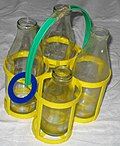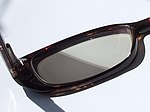temperature. There are several models used to predict liquidus and solidus curves for various systems. Detailed measurements of solidus and liquidus can...
10 KB (1,146 words) - 17:37, 3 June 2024
supercooling is observed when the liquidus temperature gradient at the interface (the position x=0) is larger than the imposed temperature gradient: ∂ T L ∂ x | x...
25 KB (3,021 words) - 11:18, 15 September 2024
Magma (section Temperature)
Gabbro may have a liquidus temperature near 1,200 °C, and the derivative granite-composition melt may have a liquidus temperature as low as about 700 °C...
63 KB (7,679 words) - 19:47, 31 October 2024
Isothermal transformation diagram (redirect from Time-temperature transformation)
rate of microconstituent growth decreases as the temperature decreases from the liquidus temperature reaching a maximum at the bay or nose of the curve...
4 KB (418 words) - 05:47, 21 November 2022
in a glass furnace at temperatures locally up to 1675 °C. The soda and the lime serve as a flux lowering the melting temperature of silica (1580 C) as...
11 KB (957 words) - 08:32, 12 October 2024
action. The filler metal is brought slightly above its melting (liquidus) temperature while protected by a suitable atmosphere, usually a flux. It then...
59 KB (6,383 words) - 12:44, 19 August 2024
Glass transition (redirect from Glass transition temperature)
relatively brittle "glassy" state into a viscous or rubbery state as the temperature is increased. An amorphous solid that exhibits a glass transition is...
58 KB (6,792 words) - 08:56, 30 September 2024
Igneous rock (section Temperature increase)
Gabbro may have a liquidus temperature near 1,200 °C, and the derivative granite-composition melt may have a liquidus temperature as low as about 700 °C...
48 KB (5,656 words) - 02:36, 23 June 2024
thermal process, the higher the temperature, the less dark photochromic lenses will be. This thermal effect is called "temperature dependency" and prevents these...
6 KB (712 words) - 19:59, 21 August 2024
First, the molten alloy reaches to liquidus temperature and then freezing range starts. At solidus temperature, the molten alloy becomes solid. Garland...
2 KB (190 words) - 07:09, 27 August 2024
they are subject to constant heating and cooling as well as dramatic temperature changes throughout the year. Moreover, they must withstand small impacts...
20 KB (2,586 words) - 15:04, 12 September 2024
melt temperature, the spectral transmission range, or the mechanical strength. Fused quartz, therefore, has high working and melting temperatures, making...
21 KB (2,394 words) - 15:12, 19 August 2024
glass. Such glass is subjected to less thermal stress and can withstand temperature differentials without fracturing of about 165 °C (300 °F). It is commonly...
30 KB (3,648 words) - 02:06, 1 September 2024
– 221 BC), and its production increased during the Han dynasty. High temperature proto-celadon glazed stoneware was made earlier than glazed earthenware...
24 KB (2,863 words) - 06:02, 3 October 2024
processing techniques is that densification is often achieved at a much lower temperature. The precursor sol can be either deposited on a substrate to form a film...
30 KB (3,801 words) - 08:05, 6 June 2024
uranium glass with certain mineral additions could be tempered at high temperatures, inducing varying degrees of micro-crystallization. This produced a range...
12 KB (1,364 words) - 15:56, 23 October 2024
Chemical vapor deposition (redirect from Low Temperature Oxide)
source gases. The filament temperature and substrate temperature thus are independently controlled, allowing colder temperatures for better absorption rates...
41 KB (4,938 words) - 07:57, 6 June 2024
drawback that it must be worked at very high temperatures. In order to lower the necessary work temperature, other materials are introduced as "fluxing...
29 KB (3,633 words) - 16:50, 30 September 2024
pigmentation, opalescence, low or even negative thermal expansion, high temperature stability, fluorescence, machinability, ferromagnetism, resorbability...
27 KB (3,634 words) - 23:18, 26 June 2024
is tuned through the fining process that heats the melt above the liquidus temperature. As the heat increases, the viscosity decreases and the melt becomes...
11 KB (1,336 words) - 04:20, 16 October 2024
softening temperature (about 600 °C or 1,112 °F), with a working point of 800 °C (1,470 °F). The viscosity of glass varies radically with temperature, but...
32 KB (3,869 words) - 16:41, 25 October 2024
annealing temperature, at which its viscosity, η, drops to 1013 Poise (1013 dyne-second/cm2). For most kinds of glass, this annealing temperature is in the...
4 KB (498 words) - 14:42, 5 July 2024
strength, toughness, ductility, hardness, corrosion resistance, high/low temperature behavior, wear resistance, and so on. Most of the traditional materials...
64 KB (6,687 words) - 12:10, 26 October 2024
CorningWare". The New York Times. Retrieved 2014-12-26. When I came back, the temperature gauge was stuck on 900 degrees, and I thought I had ruined the furnace...
10 KB (1,156 words) - 05:24, 30 October 2024
non-eutectic formulation must remain still as the temperature drops through the liquidus and solidus temperatures. Any movement during the plastic phase may...
64 KB (8,897 words) - 16:50, 20 October 2024
calculation Glass forming Glass melting Glass modeling Ion implantation Liquidus temperature sol–gel technique Viscosity Vitrification Optics Achromat Dispersion...
20 KB (2,337 words) - 06:54, 30 October 2024
professional gaming and eSports team and community website Liquidus temperature, the maximum temperature at which crystals can co-exist with the melt Teralitre...
2 KB (241 words) - 15:21, 25 August 2024
of the exothermic peak. Glass scientists also use liquidus temperature TL. Beyond this temperature liquid does not produce any crystal and it may remain...
20 KB (2,628 words) - 08:48, 18 May 2024
in a bath of a molten potassium salt (typically potassium nitrate) at temperatures of 334 °C (630 °F) or greater. This causes sodium ions in the glass surface...
4 KB (577 words) - 05:30, 22 July 2024
appreciable extent over extended periods well below the glass transition temperature is not supported by empirical research or theoretical analysis (see viscosity...
89 KB (9,113 words) - 10:13, 10 October 2024
























